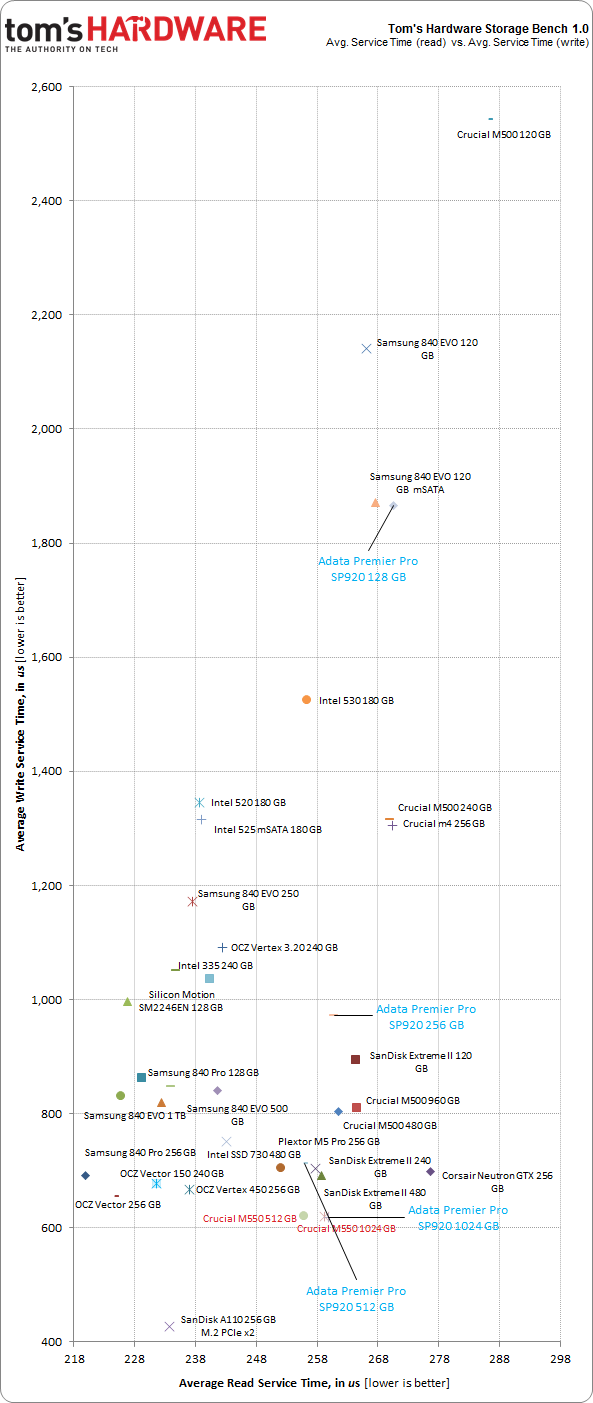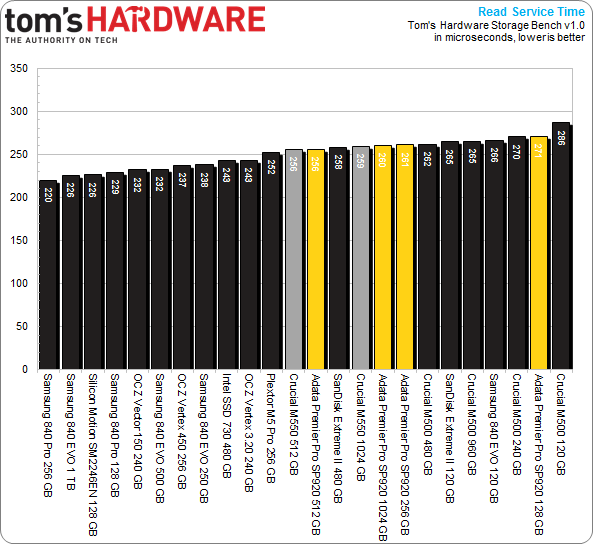Adata Premier Pro SP920 SSD: From 128 To 1024 GB, Reviewed
Adata shifts away from SandForce in its Premier Pro SP920 SSD family. With promises of incredible performance and spiffy features like DevSlp, Adata's latest employs the Marvell controller we saw in Crucial's M550. But the two share quite a bit more...
Results: Tom's Hardware Storage Bench v1.0, Continued
Service Times
Beyond the average data rate reported on the previous page, there's even more information we can collect from Tom's Hardware's Storage Bench. For instance, mean (average) service times show what responsiveness is like on an average I/O during the trace.
It would be difficult to graph the 10+ million I/Os that make up our test, so looking at the average time to service an I/O makes more sense. For a more nuanced idea of what's transpiring during the trace, we plot mean service times for reads against writes. That way, drives with better latency show up closer to the origin; lower numbers are better.
Write latency is simply the total time it takes an input or output operation to be issued by the host operating system, travel to the storage subsystem, commit to the storage device, and have the drive acknowledge the operation. Read latency is similar. The operating system asks the storage device for data stored in a certain location, the SSD reads that information, and then it's sent to the host. Modern computers are fast and SSDs are zippy, but there's still a significant amount of latency involved in a storage transaction.
When we get four models from the same product family split between a range of capacities, it's not uncommon for there to be a big delta between the smallest and largest drives.
For the most part, our tests show that read performance is similar on each drive, even though the 128 GB SP920 is just one-eighth the size of the 1024 GB model. Writes take a massive hit, though, since the smaller SSDs employ fewer dies to spread workloads across.
Mean Read Service Time
Adata's SP920s demonstrate similar read performance as the other SSDs equipped with IMFT's flash.
Finally, Adata's SP920s are vindicated. The 1024 GB model beats out the largest M550 for first place. No desktop-oriented SSD we've tested boasts such an excellent result. Yes, the margin of victory is tiny, but you can see just how compelling the competition is, as well.
Get Tom's Hardware's best news and in-depth reviews, straight to your inbox.
And we're again presented by a mystery in the 512 GB SP920. It isn't at the top of the chart alongside Crucial's M550, which is itself identical to the 1024 GB model. The difference is notable enough for us to think twice about some of the assumptions we've made about the data generated thus far. We're not talking about a crazy deficit or anything, but the drive is marginally slower in our trace-based testing. Just bear in mind that you'd have a hard time telling a difference in a real-world workload.
The 128 GB SP920 beats Samsung's 120 GB 840 EVO and Crucial's M500 at the same capacity point, which is a testament to Marvell's updated controller. Both competing SSDs use 128 Gb die as well.
Current page: Results: Tom's Hardware Storage Bench v1.0, Continued
Prev Page Results: Tom's Hardware Storage Bench v1.0 Next Page Results: TRIM Testing With ULINK's DriveMaster 2012-
cryan Reply13011395 said:I prefer Sandisk, if you don't mind.
The X210 is pretty awesome, but newer Marvell implementations are built with Haswell-style power features in mind. If you're looking for a drive to use in mobile applications, mind the heat and power consumption stats.
Regards,
Christopher Ryan -
rajangel Awhile back I purchased a few different SSD's to test out (OCZ, Crucial, Patriot, Adata). The Adata is the only one still running and was always the quickest. I don't know how this one is built, but the last Adata was built tough. The OCZ was so flimsy it felt like paper. The Crucial and the Patriot were slightly better in build quality. Now that I'm in the market for a new drive I may consider this.Reply -
cryan Reply13012280 said:Awhile back I purchased a few different SSD's to test out (OCZ, Crucial, Patriot, Adata). The Adata is the only one still running and was always the quickest. I don't know how this one is built, but the last Adata was built tough. The OCZ was so flimsy it felt like paper. The Crucial and the Patriot were slightly better in build quality. Now that I'm in the market for a new drive I may consider this.
I have to say, the plastic or metal chassis a drive comes in doesn't mean much. In the lab, I like a nice heavy metal SSD casing, but in a laptop? You probably want a flimsy plastic chassis. It's not conductive and doesn't add much weight.
Regards,
Christopher Ryan -
rajangel It's a matter of opinion. I like things that are built well, and have a quality appearance. I think build quality does affect performance (read reliability). Especially when connectors/etc are cheap in construction. However, just my opinion.Reply -
cryan Reply13012326 said:It's a matter of opinion. I like things that are built well, and have a quality appearance. I think build quality does affect performance (read reliability). Especially when connectors/etc are cheap in construction. However, just my opinion.
I agree that a substantial chassis tends to reinforce the perception of a drive's build quality, but much of the time its aesthetic. The component choice on the PCB speaks more to quality. I've seen some downright terrible drives in the fanciest of cases.
Regards,
Christopher Ryan
-
rajangel I think there should be a restriction that prevents the article author from replying, unless there is a substantial mistake that was noted. I feel like tomshardware authors troll their own threads. This has become a problem lately. I'm at the point where I feel my business and time would be better spent on a real tech website. Tomshardware is like the Yahoo of tech sites lately.Reply -
iltamies Typo on last page: "Adata gets a solid product able to soften the wait, and Micron (Crucial's parent company) gets to more more volume." should read "move more volume."Reply -
Wisecracker Impressive ... power consumption is a bit high though, compared to the Samsung 120GB Evo (my current $80 fav)Reply
Are 'microseconds' considered 'milliseconds' ??


